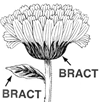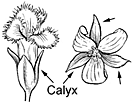Āulu
Rockia sandwicensis
Verbena/Four-O'Clock family (Nyctaginaceae)
Native species ()
Small to medium-sized native tree of dry forests, recognized from a distance by the dark green color of the large oblong leathery leaves. To about 50 ft (15 ) high with up to three trunks 1–2 ft (0.3–0.6 ) in diameter. Bark dark gray, smoothish to finely fissured. Inner bark is whitish, slightly bitter. Twigs light gray, with large raised half-round leaf-scars.

©2012 Forest And Kim Starr
Flower clusters rounded on stalks of 1 1⁄4–5 1⁄4 inches (3–6 ) at leaf bases. Male and female flowers are many, on different trees (), with 2–3 or at base and narrow greenish tubular about 1⁄4 inch (6 ) long, finely hairy, fragrant. Male flowers many, stalkless in rounded head about 2 inches (5 ) in diameter, consisting of deeply 5–6- tubular with five short about 20 minute sterile inside tube, and with narrow slender and enlarged fringed
(anthocarp) cylindrical, about 1 1⁄2 inches (4 ) long and very narrow, widest below middle, composed of enlarged with at and many faint lines and enclosing the narrow one-seeded () with at
Wood whitish, soft, very lightweight and porous, brash, not used. Tends to separate or “honeycomb” when dried. Highly susceptible to fungal stain. Branches are brittle and easily broken.
Widespread in dry forests through the islands, especially at 2000–2500 ft (610–762 ) altitude.
Special areas
Kokee, Waimea Arboretum
Range
Hawaiian Islands only
Other common name
pāpala kēpau
Botanical
Pisonia sandwicensis Hillebr






